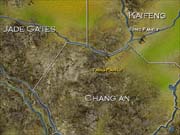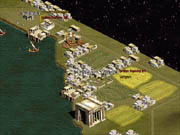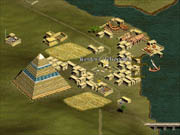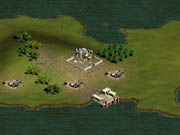Many strategy games incorporate trade as one of the central challenges for the player to overcome in building an empire. But perhaps none re-creates the art of buying low and selling high in such detail as Trade Empires. The game puts you in charge of a merchant family with the straightforward goal of growing as wealthy as possible in a variety of scenarios that cover a vast reach of history, from the first civilizations of the Mesopotamian and Indus river valleys to medieval China and industrialized Britain. The single-minded focus and historical scope promise great depth and variety, but Trade Empires asks a lot of the player without providing much payoff. The limited management interface, slow pacing, and subpar computer competition make the busywork of running a merchant house an unfulfilling task.

Trade Empires is built on a tradition of conquest-driven empire games, but it strips the model down to its economic core. The game's developer, Frog City, previously created the Imperialism games, which strongly tie the military rise of European powers to mercantilism. Trade Empires does away with political borders and military operations. Now profit is both a means and an end. But your itinerant merchants aren't just piggybacking on natural economic growth. The trade routes you and your competitors create shape the ancient world. Markets with plentiful food and luxuries will encourage the local population to grow from nothing into bustling cities in the course of decades.
The game's scenarios depict times of great opportunity, when shifts in markets and commodity demands create an environment that might allow a successful trader to become a merchant prince. In most cases, it's entirely your responsibility to build the infrastructure required for trade. New trading posts and cities must be placed near scattered natural resources and then connected with roads or sea and river ports. You'll build an economy around the manageable number of commodities (like flax, silk, and iron), luxuries (like incense, copper urns, and cigars), and military goods (like copper arrows, bronze swords, and gunpowder) that are picked for each episode. Most of the trade goods require at least one refining step, and the most lucrative require two. This often means transporting raw materials from their source to a market with a production building that can refine and combine the necessary resources before delivering the final products to their destination. In addition to hauling goods around, you can build and run the production centers--which vary from simple one-resource craftsmen, such as carpenters who just require wood, to luxury-producing artisans, like jewelers who can combine either refined silver ingots with pearls or gold ingots with lapis.

To supplement the demand created by the city dwellings that automatically pop up and demand basic goods, you can purchase demand buildings that make the luxury trade more lucrative. In some cases, the best approach to really expanding your wealth is to build small markets just containing palaces, ziggurats, and the like to add volume to the luxury trade without burdening your merchants with demand for less-remunerative items like food. The range of products available will naturally depend on the time period, but as an episode progresses, you'll be able to buy technological advances that allow for new products, buildings, and means of transportation. As with infrastructure construction, technology is immediately available once purchased. Only trade and economic development require the real-time game clock to run.
The real work starts when you've laid down the infrastructure for your business. The central tension in Trade Empire's economy is between the need to oversupply new markets to keep prices low for city growth and the overall goal of creating enough demand for goods to drive the price up and pad profits. Your merchants are the driving economic force, as they run through preset trade routes, buying and selling on spot market prices. A surplus of goods in the market drives prices down over time, and a shortage brings prices up. Each scenario is divided up into a handful of square regions that are abstractly connected by land and sea routes. Often, an essential resource is located in only one or two of the regions, so far-flung colonies must be established to bring these goods back. The map doesn't have a zoom feature that lets you get a look at everything at once, but there is a regional overlay map that's useful for spotting resources and planning your strategy. With such large distances to move goods across, it can be quite a challenge to turn a profit, even if merchants are meeting demands and encouraging growth.
Trade Empires makes you keep a constant watch on price fluctuations, as your merchants will follow your preset orders to the letter, just as gladly dumping products for a loss as selling them at a premium. However, the game doesn't give you centralized tools for either monitoring markets' demands or measuring the success of trade routes. For a game focused on financial management, it's astounding that there are no graphs of any kind at your disposal. There are only two simple counters for gauging your success: the amount of gold currently in your treasury and each merchant's lifetime earnings or losses. Fortunately, you can reset the merchant counters periodically, since it's otherwise impossible to tell if a long-profitable route has turned into a money-losing endeavor.

It's a good thing that Trade Empires' economic model presents a decent challenge, because your own high scores are the best source of competition. The episodes are balanced so there's just enough time (usually several centuries) to develop a solid economy and then watch the money come in. There's a limit of 30 merchants, a number that isn't hard to reach after setting up some distant colonies, so it's a good idea to make sure each one counts. With transportation advances, it's possible to improve the efficiency of trade routes considerably over the course of an episode, but this does require combing through each one and redesigning those that are inefficient. Even with many routes, the interface isn't confusing, but it does require a lot of clicking through pull-down menus.
Victory in the game's various scenarios amounts to racking up a high score. That is, if you're hoping for varied scenario objectives, then you'll be disappointed. In fact, the game's victory conditions screen is really just a summary of how any given scenario is scripted to unfold as new technologies become available. It doesn't help that the artificial intelligence for competing merchant families seems faulty or at least not very engaging. In several episodes against the AI, the competition quickly ran out of funds to buy goods for trade and subsequently spent the rest of the time doing nothing, its merchants holed up in towns. It would have been better if the AI traders just declared bankruptcy and let new competitors take their place. The only combat in the game is handled through abstract encounters--bandits and buccaneers will occasionally stop a merchant crossing between regions. As insurance, you need to hire various guard types to prevent losing your cargo and having to ransom your merchant, but this is one of the least involving of your management duties.

The game's 2D graphics are well rendered, but the visual style is somewhat bland and sparse despite the welcome diversity in graphics for structures built in different regions and time periods. When you change regions within an episode, you might notice that palaces and dwellings look different, and there's also a short bit of music themed for the local culture. This is the only music in the game, and the rest of the game's audio comprises a few limited sound effects. At least the clink of money exchanging hands is well represented. You'll hear it often.
Trade Empires blends elements from management games like Railroad Tycoon II and empire games like Imperialism II, but in stripping away all real competition and generalizing an economic system for 4,000 years of human civilization, the game loses the specificity and dramatic conflict that make such games so addicting. The lack of detailed economic graphs also means you don't get the satisfaction of being able to see how you've progressed over time. While there are plenty of episodes to keep you busy, the play style is functionally uniform, and unless high score rankings mean something to you, there's little intrinsic replay value to the scenarios. Trade Empires lays out a broad and varied economic world that's initially interesting to explore, but over time, this doesn't justify all the effort the game demands.